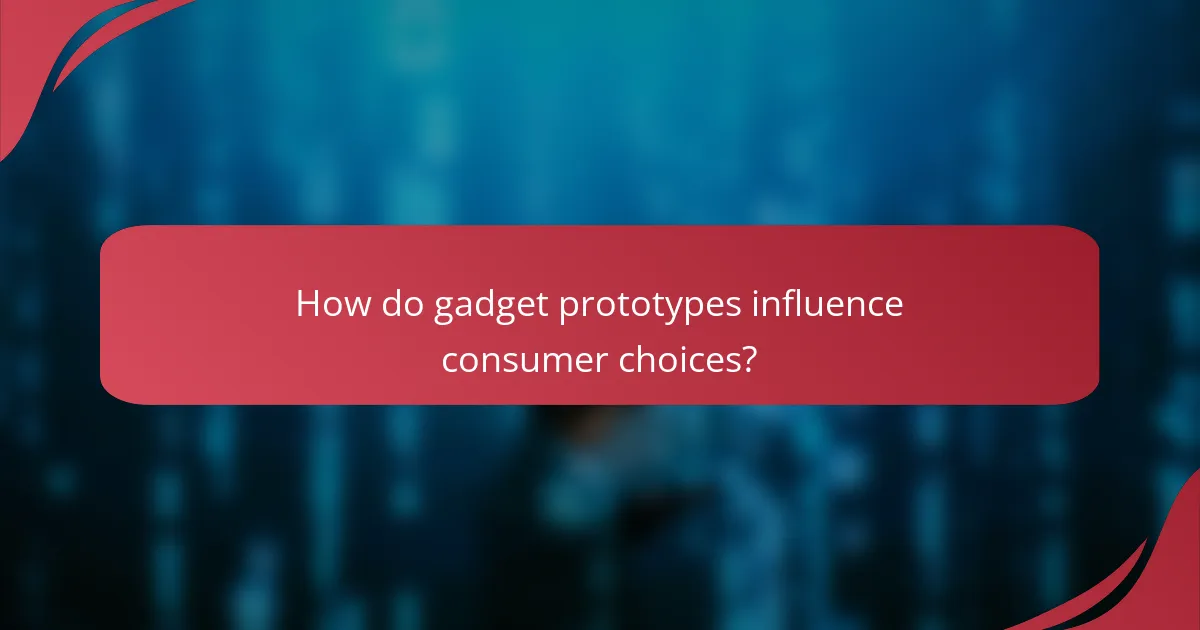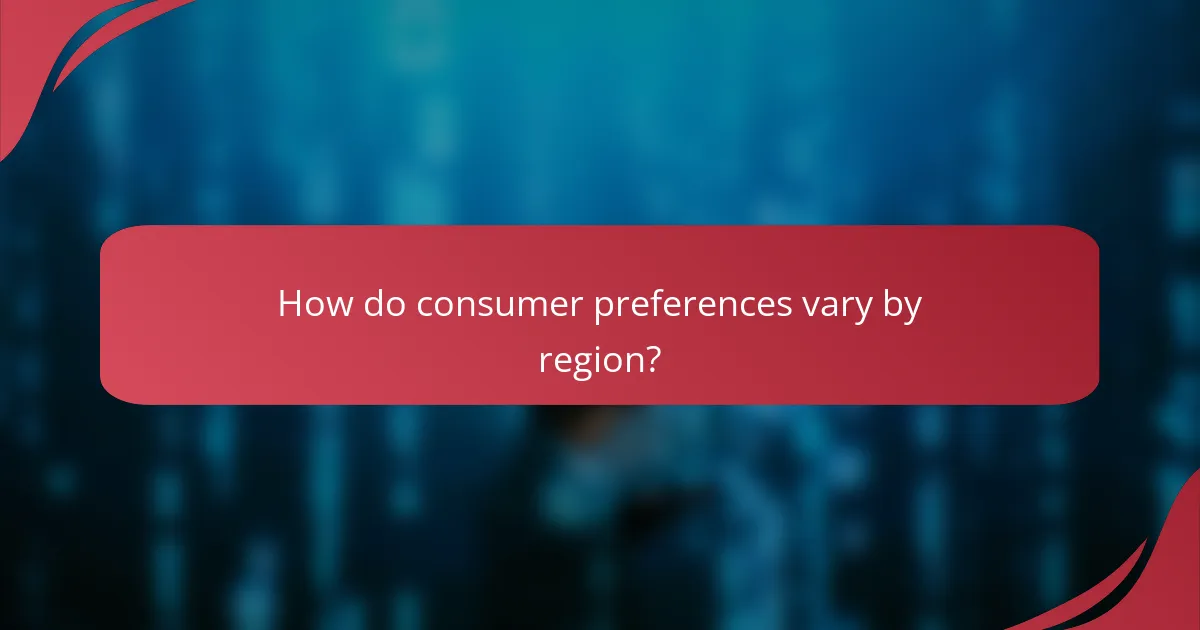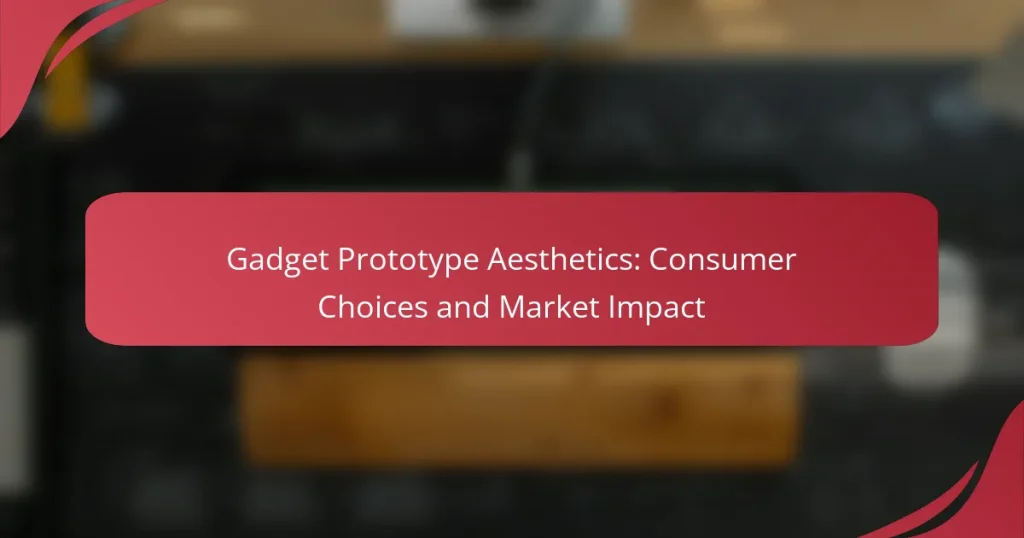Gadget prototypes play a crucial role in shaping consumer choices by establishing expectations around design and functionality. Aesthetics such as minimalist design, color psychology, and material selection directly impact consumer preferences and market success. Additionally, cultural values and regional trends further influence how these prototypes are perceived, guiding manufacturers in tailoring their products to meet diverse consumer demands.

How do gadget prototypes influence consumer choices?
Gadget prototypes significantly shape consumer choices by setting expectations for design, functionality, and brand identity. Consumers often make purchasing decisions based on their perceptions of these prototypes, which can lead to increased interest or skepticism in the final product.
Design aesthetics impact purchasing decisions
Design aesthetics play a crucial role in attracting consumers and influencing their purchasing decisions. A visually appealing prototype can create a strong first impression, often leading to higher interest and perceived value. For example, sleek, modern designs may appeal to tech-savvy individuals, while colorful, playful designs might attract younger audiences.
Moreover, a well-designed prototype can communicate quality and innovation, encouraging consumers to associate the product with positive attributes. Companies should prioritize user-friendly interfaces and ergonomic designs to enhance consumer satisfaction and drive sales.
Brand perception shapes consumer preferences
Brand perception significantly influences consumer preferences when evaluating gadget prototypes. Established brands often benefit from consumer trust and loyalty, making it easier for them to introduce new products. Conversely, lesser-known brands may struggle to gain traction, even if their prototypes are innovative.
To improve brand perception, companies should focus on consistent messaging and quality across their product lines. Engaging marketing campaigns that highlight unique features and benefits can also enhance consumer interest and drive purchasing decisions.
Functionality vs. aesthetics in consumer evaluation
Consumers often weigh functionality against aesthetics when evaluating gadget prototypes. While a visually appealing design can attract attention, the product must also deliver on performance and usability. For instance, a smartphone with an attractive design but poor battery life may fail to meet consumer expectations.
To strike a balance, companies should ensure that their prototypes not only look good but also offer practical features that enhance user experience. Conducting user testing can provide valuable insights into consumer preferences, helping brands refine their prototypes before launch.

What are the key aesthetic trends in gadget prototypes?
Key aesthetic trends in gadget prototypes include minimalist design, color psychology, and material choices. These elements significantly influence consumer preferences and market success by enhancing usability and visual appeal.
Minimalist design in tech gadgets
Minimalist design emphasizes simplicity and functionality, often featuring clean lines and uncluttered interfaces. This approach appeals to consumers seeking intuitive products that fit seamlessly into their lifestyles.
For example, gadgets like smart speakers and wearables often adopt minimalist aesthetics, focusing on essential features while eliminating unnecessary embellishments. This trend can enhance user experience and foster brand loyalty.
Color psychology in product appeal
Color psychology plays a crucial role in attracting consumers to gadget prototypes. Different colors evoke specific emotions and associations, influencing purchasing decisions. For instance, blue often conveys trust and reliability, while red can stimulate excitement and urgency.
When designing gadgets, brands should consider their target audience and the emotions they wish to evoke. A well-chosen color palette can significantly enhance a product’s marketability and consumer engagement.
Material choices affecting consumer attraction
The materials used in gadget prototypes can greatly impact consumer attraction and perceived value. High-quality materials like aluminum or glass often suggest durability and premium quality, while plastic may be viewed as less desirable.
Brands should balance cost and aesthetics when selecting materials. For instance, eco-friendly materials are increasingly popular among consumers who prioritize sustainability, making them a smart choice for modern gadget design.

How do consumer preferences vary by region?
Consumer preferences for gadget aesthetics differ significantly across regions, influenced by cultural values, technological trends, and market demands. Understanding these variations helps manufacturers tailor their designs to meet local expectations and enhance market appeal.
North American trends in gadget aesthetics
In North America, consumers often prioritize functionality and sleek designs in gadgets. Minimalist aesthetics, with clean lines and neutral colors, are particularly popular, reflecting a preference for modernity and simplicity.
Additionally, eco-friendly materials are gaining traction, as consumers increasingly value sustainability. Brands that incorporate recycled materials or emphasize energy efficiency tend to resonate well with this audience.
European consumer preferences for design
European consumers typically favor innovative and artistic designs, often seeking unique features that set products apart. This market appreciates craftsmanship and is willing to pay a premium for gadgets that showcase superior design quality.
Moreover, regional variations exist within Europe; for instance, Scandinavian countries lean towards minimalism, while Southern Europe may prefer vibrant colors and bold styles. Understanding these nuances is crucial for brands aiming to penetrate the European market.
Asian market influences on gadget aesthetics
In Asia, gadget aesthetics are heavily influenced by technology trends and cultural factors. For instance, sleek, high-tech designs are favored in countries like Japan and South Korea, where consumers often seek the latest innovations.
Additionally, social status plays a significant role in consumer choices. Premium brands that offer exclusive designs or limited editions can attract affluent buyers. Companies should consider local tastes and cultural symbols to effectively engage this diverse market.

What factors drive market impact of gadget aesthetics?
The market impact of gadget aesthetics is primarily driven by consumer preferences, design choices, and social influences. A well-designed gadget can significantly enhance sales and brand loyalty, making aesthetics a crucial factor in product development.
Sales performance linked to design choices
Design choices directly affect sales performance, as consumers often make purchasing decisions based on visual appeal. Gadgets with sleek, modern designs tend to attract more buyers, leading to higher sales figures. For instance, products with minimalist aesthetics often see a boost in popularity, especially among tech-savvy consumers.
Moreover, color schemes and material quality can influence perceived value. High-quality materials and unique finishes can justify higher price points, appealing to consumers willing to invest more in premium products.
Influence of social media on aesthetic trends
Social media plays a significant role in shaping aesthetic trends for gadgets. Platforms like Instagram and TikTok allow users to showcase their gadgets, influencing others’ perceptions and preferences. Viral trends can lead to rapid shifts in what consumers find appealing, making it essential for brands to stay updated.
Additionally, influencers often highlight specific design elements, creating demand for products that align with current aesthetic trends. Brands that effectively leverage social media marketing can enhance their visibility and drive sales through visually appealing content.
Consumer feedback shaping future designs
Consumer feedback is vital in shaping future gadget designs, as companies often rely on reviews and surveys to understand preferences. Gathering insights from early adopters can help brands refine aesthetics to better meet market demands. For example, if a particular color or form factor receives positive feedback, it may become a standard in future models.
Brands that actively engage with their customers and incorporate feedback into their design processes can foster loyalty and create products that resonate with their target audience. This iterative approach ensures that aesthetics align with consumer expectations, ultimately driving market success.

How can brands leverage aesthetics for competitive advantage?
Brands can leverage aesthetics by creating visually appealing products that resonate with consumers, enhancing brand identity and loyalty. A strong aesthetic strategy can differentiate a brand in a crowded market, influencing purchasing decisions and fostering emotional connections.
Brand storytelling through design
Design serves as a powerful medium for brand storytelling, allowing companies to convey their values and mission visually. By integrating elements that reflect their heritage or future aspirations, brands can create a narrative that resonates with their target audience. For instance, a tech company might use sleek, modern designs to symbolize innovation and forward-thinking.
Effective storytelling through design often involves consistent use of colors, shapes, and materials that align with the brand’s identity. This consistency helps consumers recognize and remember the brand, reinforcing their loyalty over time.
Creating emotional connections with aesthetics
Aesthetics play a crucial role in forming emotional connections with consumers. Products that evoke positive feelings through their design can lead to increased customer satisfaction and loyalty. For example, a smartphone with a minimalist design may appeal to consumers seeking simplicity and elegance.
Brands should consider the psychological impact of colors and shapes in their designs. Warm colors can create feelings of comfort, while bold shapes may evoke excitement. Understanding these emotional triggers can help brands tailor their aesthetics to better connect with their audience.
Case studies of successful aesthetic strategies
Several brands have successfully utilized aesthetics to gain a competitive edge. Apple is a prime example, with its focus on sleek, minimalist design that emphasizes user experience and innovation. This aesthetic not only attracts consumers but also reinforces its brand image as a leader in technology.
Another example is Coca-Cola, which uses its iconic red and white color scheme and classic bottle shape to create a strong visual identity. This consistency across products and marketing materials has helped Coca-Cola maintain its status as a beloved global brand.

